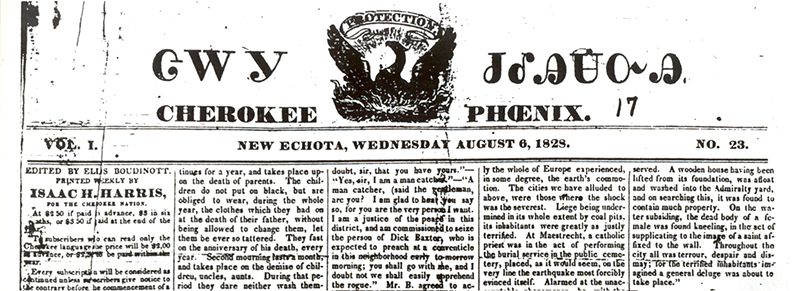The Encyclopedia of Oklahoma History and Culture
CHEROKEE PHOENIX.
The Cherokee Phoenix was established as the Cherokee Nation's official weekly newspaper and the first published by an American Indian tribe. Formally approved by the Cherokee national council in 1826, the first issue of the Cherokee Phoenix was published on February 21, 1828, at the Cherokee capital of New Echota, Georgia. It featured news of the day, laws and public documents of the Cherokee Nation, and articles to encourage "civilization" printed in English and Cherokee using Sequoyah's Cherokee syllabary.
Elias Boudinot (Buck Oowatie), who was educated in the Cornwall Seminary, in Connecticut, served as its first editor and raised money for the newspaper through his speaking engagements in the northeast. His efforts were aided by his brother Stand Watie, John Ridge, Elijah Hicks, and the American Board of Commissioners for Foreign Missions. The paper reflected the Cherokee "renaissance" of cultural development and the formal organization of the Cherokee national government in northern Georgia. The name of the paper was changed in 1829 to the Cherokee Phoenix and Indians' Advocate, and its content addressed the issues of assimilation and removal that affected the Cherokee and other tribes. It offered extensive coverage of congressional debates over removal, U.S. Supreme Court cases impacting Cherokee rights (i.e., Cherokee Nation v. Georgia and Worcester v. Georgia), and Georgia's and the United States' efforts to terminate Cherokee land title.
In its early years Principal Chief John Ross used the paper as the national voice of the Cherokee. Boudinot provided strong support for the nationalistic movement led by Ross through his writings, which criticized the Indian Removal Act of 1830, the encroachments of Georgia settlers, and the state courts that refused the testimony of Cherokee witnesses. However, after John Ridge, his cousin, began to openly advocate removal in 1832, Boudinot began writing editorials supporting emigration and expressing doubt that the Nation could survive in the East. When his opinions on removal spread to other news items, Ross pressured Boudinot to resign on August 1, 1832.
The Phoenix continued under its new editor, Elijah Hicks, Ross's brother-in-law. Hicks opposed removal, and his editorials revealed his alliance with the Ross party and his opposition to the removal party led by Major Ridge, John Ridge, and Boudinot. Due to the actions of the federal government and lack of financial resources, the last issue of the paper was printed at New Echota on May 31, 1834.
See Also
Bibliography
Duane H. King, ed., The Cherokee Indian Nation: A Troubled History (Knoxville: University of Tennessee Press, 1979).
William G. McLoughlin, Cherokees and Missionaries, 1789–1839 (New Haven, Conn.: Yale University Press, 1984).
William G. McLoughlin, Cherokee Renascence in the New Republic (Princeton, N.J.: Princeton University Press, 1986).
Robert G. Martin, Jr., "The Cherokee Phoenix: Pioneer of Indian Journalism," The Chronicles of Oklahoma 25 (Summer 1947).
Theda Perdue, ed., Cherokee Editor: The Writings of Elias Boudinot (Knoxville: University of Tennessee Press, 1983).
Citation
The following (as per The Chicago Manual of Style, 17th edition) is the preferred citation for articles:
James P. Pate, “Cherokee Phoenix,” The Encyclopedia of Oklahoma History and Culture, https://www.okhistory.org/publications/enc/entry?entry=CH022.
Published January 15, 2010
© Oklahoma Historical Society


